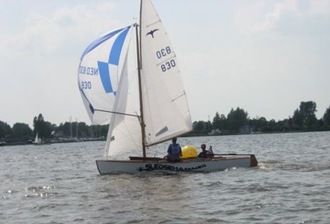I've not been able to post on the regular schedule this week, my apologies for that. I've a lot on my plate and some things have fallen behind. I do have a couple of days to get up to speed before the next event, so hopefully I will be able to catch up. This weeks post is again about rule 18;
18.2 and 18.5 are completely rewritten, 18.3 and 18.4 are only 'tweaked' a little:
18.2 Giving Room; Keeping Clear
(a) overlapped – basic rule
When boats are overlapped the outside boat shall give the inside boat room to round or pass the mark or obstruction, and if the inside boat has right of way the outside boat shall also keep clear. Other parts of rule 18 contain exceptions to this rule.
(b) overlapped at the zone
If boats were overlapped before either of them reached the two-length zone and the overlap is broken after one of them has reached it, the boat that was on the outside shall continue to give the other boat room. If the outside boat becomes clear astern or overlapped inside the other boat, she is not entitled to room and shall keep clear.
(c) not overlapped at the zone
If a boat was clear ahead at the time she reached the two-length zone, the boat clear astern shall thereafter keep clear. If the boat clear astern becomes overlapped outside the other boat, she shall also give the inside boat room. If the boat clear astern becomes overlapped inside the other boat, she is not entitled to room. If the boat that was clear ahead passes head to wind, rule 18.2(c) no longer applies and remains inapplicable.
(d) changing course to round or pass
When after the starting signal rule 18 applies between two boats and the right-of-way boat is changing course to round or pass a mark, rule 16 does not apply between her and the other boat.
(e) overlap rights
If there is reasonable doubt that a boat obtained or broke an overlap in time, it shall be presumed that she did not. If the outside boat is unable to give room when an overlap begins, rules 18.2(a) and 18.2(b) do not apply.
18.2 Giving Mark-Room
(a) When boats are overlapped the outside boat shall give the
inside boat mark-room, unless rule 18.2(b) applies.
(b) If boats are overlapped when the first of them reaches the zone, the outside boat at that moment shall thereafter give the inside boat mark-room. If a boat is clear ahead when she reaches the zone, the boat clear astern at that moment shall thereafter give her mark-room.
(c) When a boat is required to give mark-room by rule 18.2(b), she shall continue to do so even if later an overlap is broken or a new overlap begins. However, if either boat passes head to wind or if the boat entitled to mark-room leaves the zone, rule 18.2(b) ceases to apply.
(d) If there is reasonable doubt that a boat obtained or broke an overlap in time, it shall be presumed that she did not.
(e) If a boat obtained an inside overlap from clear astern and, from the time the overlap began, the outside boat has been
unable to give mark-room, she is not required to give it.
18.3 Tacking at When Approaching a Mark
If two boats were approaching a mark on opposite tacks and one of them completes a tack changes tack, and as a result is subject to rule 13 in the two-length zone when the other is fetching the mark, rule 18.2 does not thereafter apply. The boat that tacked changed tack
(a) shall not cause the other boat to sail above close-hauled to avoid her or prevent the other boat from passing the mark on the required side, and
(b) shall give mark-room if the other boat becomes overlapped
inside her, in which case rule 15 does not apply.
18.4 Gybing
When an inside overlapped right-of-way boat must gybe at a mark or obstruction to sail her proper course, until she gybes she shall sail no farther from the mark or obstruction than needed to sail that course. Rule 18.4 does not apply at a gate mark.
18.5 Passing a Continuing Obstruction
While boats are passing a continuing obstruction, rules 18.2(b) and 18.2(c) do not apply. A boat clear astern that obtains an inside overlap is entitled to room to pass between the other boat and the obstruction only if at the moment the overlap begins there is room to do so. If there is not, she is not entitled to room and shall keep clear.
18.5 Exoneration
When a boat is taking mark-room to which she is entitled, she shall be exonerated
(a) if, as a result of the other boat failing to give her mark-room, she breaks a rule of Section A, or
(b) if, by rounding the mark on her proper course, she breaks a rule of Section A or rule 15 or 16.
Like stated last week, rule 18 is now only applicable at marks! Obstructions will be dealt with in rule 19.
With the new wording a couple of the Q&A's have been sorted out once and for all. For instance: Rule 18.4 has no effect at the gate anymore.















